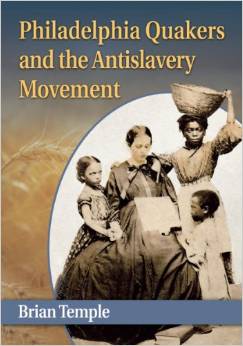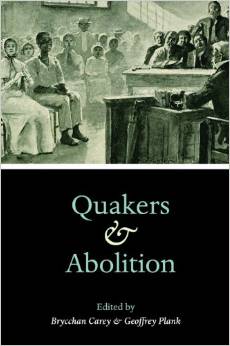Philadelphia Quakers and the Antislavery Movement / Quakers and Abolition
Reviewed by Cameron McWhirter
April 1, 2015
 Philadelphia Quakers and the Antislavery Movement: By Brian Temple. McFarland & Company Inc., 2014. 240 pages. $39.95/paperback; $24.99/eBook.
Philadelphia Quakers and the Antislavery Movement: By Brian Temple. McFarland & Company Inc., 2014. 240 pages. $39.95/paperback; $24.99/eBook.
Quakers and Abolition: Edited by Brycchan Carey and Geoffrey Plank. University of Illinois Press, 2014. 280 pages. $45/hardcover; $40.50/eBook.
Buy on FJ Amazon StoreQuakers are known as a humble people, but it’s a thin line between sincere humility and smugness. Quaker historians have produced celebratory biographies of John Woolman, Lucretia Mott, Levi Coffin, and others who risked a great deal to fight slavery and its ugly legacies. These people were on the right side of history, and they deserve attention.
But many early Quakers supported slavery—at least initially—and still others advocated “solutions” or compromises to the slavery problem that would make modern Americans recoil. These ugly truths of the long and complex interplay between the peculiar institution of slavery and the peculiar Religious Society of Friends have received scant attention. (A notable exception is Fit for Freedom, Not for Friendship: Quakers, African Americans, and the Myth of Racial Justice by Donna McDaniel and Vanessa Julye, published in 2009 by QuakerPress, which explores racism among Quakers, even those who supported abolition.)
Two new books set out to correct this deficiency by exploring all aspects of the Quaker relationship to slavery. These books are welcome, yet they only tell portions of a much larger story—one book focuses only on the Philadelphia area and the other is a collection of academic essays that have little in common in substance or style beyond the overarching theme. Larger, more comprehensive works on the Quakers and slavery are needed and hopefully these two books will inspire historians to get to work.
Philadelphia Quakers and the Antislavery Movement, written by independent historian Brian Temple, is the more accessible of the two works, being less academic in style and with a focused narrative. With thorough research and unadorned writing, Temple tells how a core group of Quakers in Philadelphia and New Jersey fought against slavery as early as 1688, when members of the Germantown meeting wrote a letter declaring they were “against the traffick of men-body.”
He tells the fascinating story of abolitionist Benjamin Lay, a four-foot-tall hunchback, who sprayed blood-like dye while vociferously speaking against slavery at a New Jersey meeting. Temple shows that the Quaker community as a whole had to be convinced over many years to oppose slavery. Eventually most Quakers were—with many freeing their slaves and even paying “reparations” of sorts to get the newly freed African Americans settled. Temple tells the story of the Free Produce Society, led by Quakers, to sell goods made without slave-produced material. He explores extensive Quaker involvement in the Underground Railroad and in protecting slaves who escaped to the Philadelphia area.
 But Temple also writes about the American Colonization Society, which Quakers helped to create. That group worked to send all slaves back to Africa, a controversial, incremental “solution” to ending slavery that today is viewed as not only absurd, but also inherently racist. Temple’s book is limited in part by geography. He virtually ignores Quaker efforts regarding abolition in North Carolina, Indiana, and elsewhere. Quakers and Abolition, a collection of 14 essays edited by two British professors, covers much more ground but has a piecemeal quality, with chapters gleaned from widely diverse papers presented at a 2010 Quaker history conference. The book makes clear that Quakers from the earliest days were troubled by slavery, but that does not mean all members fiercely pushed for its abolition.
But Temple also writes about the American Colonization Society, which Quakers helped to create. That group worked to send all slaves back to Africa, a controversial, incremental “solution” to ending slavery that today is viewed as not only absurd, but also inherently racist. Temple’s book is limited in part by geography. He virtually ignores Quaker efforts regarding abolition in North Carolina, Indiana, and elsewhere. Quakers and Abolition, a collection of 14 essays edited by two British professors, covers much more ground but has a piecemeal quality, with chapters gleaned from widely diverse papers presented at a 2010 Quaker history conference. The book makes clear that Quakers from the earliest days were troubled by slavery, but that does not mean all members fiercely pushed for its abolition.
George Fox, visiting Barbados, declared, “Christ dyed for the Tawne[y]s and for the Blacks, as well as you that are called whites,” and urged plantation owners to instruct their slaves in Christian values. But he did not urge slaves to be freed. He seemed more concerned about slaves ending polygamist marriages than securing their manumission.
One of the most interesting essays is by Thomas Hamm, a history professor at Earlham College. He writes about George Fox White, a Hicksite preacher who became a fierce opponent of Quaker involvement in abolition.
“I had a thousand times rather be a slave, and spend my days with slaveholders, than to dwell in companionship with abolitionists,” White wrote. Few Quakers today could conceive that such a position was ever taken by a prominent member of the Society.
Both books are important contributions, but they are only partial explorations of the fascinating and complex story of Quakerism’s shifting relationship with slavery. This is a story that goes to the very heart of the Quaker experience: members were led by divine direction, by the Light that is within everyone, to see the fundamental evilness of slavery, even when many others simply viewed it as part of the economic and social order. A handful of active Quakers spoke out and argued with each other; they formed organizations and pressed governments. In short, they changed the world, but not before they went through the often-painful process of changing themselves and convincing their fellow members to change. I look forward to more historians pursuing this amazing story.



Comments on Friendsjournal.org may be used in the Forum of the print magazine and may be edited for length and clarity.